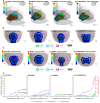Influence of pacifier design on pacifier-palate contact: a finite element analysis
- PMID: 40640845
- PMCID: PMC12247239
- DOI: 10.1186/s13005-025-00525-6
Influence of pacifier design on pacifier-palate contact: a finite element analysis
Abstract
Objective: The study compares the contact pressure and pressure distribution of various pacifier shapes on the palatal surfaces of newborns and six-month-old infants using nonlinear finite element analysis (FEA). Additionally, it seeks to assess the extent and pattern of interaction between pacifier designs and the lateral and medial zones of the palates.
Materials and methods: 3D finite element models of four pacifiers (A = NUK®, B = MAM®, C = BIBS®, D = CURAPROX®) of newborn and six-month-old palate and tongue were developed. The palate geometries were based on dental stone impressions of a neonate and six-month-old infant. The pacifier designs were digitized using computed tomography and analyzed in ANSYS Mechanical 2024 R1 (Ansys, Inc., Canonsburg, USA). Hyperelastic silicone rubber properties were used, while the palate and tongue were modeled as rigid and the mucosa as flexible. The interaction between different pacifier designs and the palate of a newborn was assessed through deformation, contact area, and contact pressure relative to the vertical tongue displacement in the anterior, medial, and lateral zones of the palates.
Results: Pacifier D exhibited the highest lateral and medial pressures on both the newborn and six-month-old palates with its broad-winged design. Pacifiers A and B showed moderate but steady increases in lateral pressure. In contrast, pacifier C showed concentrated pressure in the anterior zone with its distinct, rounded shape, particularly on the newborn palate. Pressure distribution patterns differed significantly between pacifier designs, with pacifier D showing the most extensive and uniform pressure distribution across the palate.
Conclusions: Pacifier design significantly influences palatal interaction, with broader shapes resulting in higher pressure concentrations on the lateral sides that may affect the transversal palate dimension. Understanding the biomechanical impacts of pacifier use is the first step in giving valuable insights to both clinicians and parents in making informed decisions regarding pacifier selection to support optimal oral development. Further clinical studies are needed to validate these findings.
Keywords: Finite element analysis; Infant; Non-Nutritive sucking; Oral development; Pacifier morphology; Palatal pressure.
© 2025. The Author(s).
Conflict of interest statement
Declarations. Ethics approval and consent to participate: Not applicable. Consent for publication: Not applicable. Informed consent: Not applicable. Competing interests: The authors declare no competing interests.
Figures






Similar articles
-
Advancing the assessment of pacifier effects with a novel computational method.BMC Oral Health. 2024 Jan 16;24(1):87. doi: 10.1186/s12903-023-03848-5. BMC Oral Health. 2024. PMID: 38229079 Free PMC article.
-
Interventions for the cessation of non-nutritive sucking habits in children.Cochrane Database Syst Rev. 2015 Mar 31;2015(3):CD008694. doi: 10.1002/14651858.CD008694.pub2. Cochrane Database Syst Rev. 2015. PMID: 25825863 Free PMC article.
-
The effect of pacifier sucking on orofacial structures: a systematic literature review.Prog Orthod. 2018 Mar 13;19(1):8. doi: 10.1186/s40510-018-0206-4. Prog Orthod. 2018. PMID: 29532184 Free PMC article.
-
Effect of restricted pacifier use in breastfeeding term infants for increasing duration of breastfeeding.Cochrane Database Syst Rev. 2016 Aug 30;2016(8):CD007202. doi: 10.1002/14651858.CD007202.pub4. Cochrane Database Syst Rev. 2016. PMID: 27572944 Free PMC article.
-
Functional comparison of pacifiers using finite element analysis.BMC Oral Health. 2022 Mar 2;22(1):49. doi: 10.1186/s12903-022-02087-4. BMC Oral Health. 2022. PMID: 35236336 Free PMC article.
References
-
- Adair SM. Pacifier use in children: a review of recent literature. Pediatr Dent. 2003;25(5):449–58. - PubMed
-
- Callaghan A, Kendall G, Lock C, Mahony A, Payne J, Verrier L. Association between pacifier use and breast-feeding, sudden infant death syndrome, infection and dental malocclusion. Int J Evid Based Healthc. 2005;3(6):147– 67. 10.1111/j.1479-6988.2005.00024.x. PMID: 21631747. - PubMed
-
- Poyak J. Effects of pacifiers on early oral development. Int J Orthod Milwaukee. 2006;17(4):13–6. PMID: 17256438. - PubMed
MeSH terms
LinkOut - more resources
Full Text Sources

